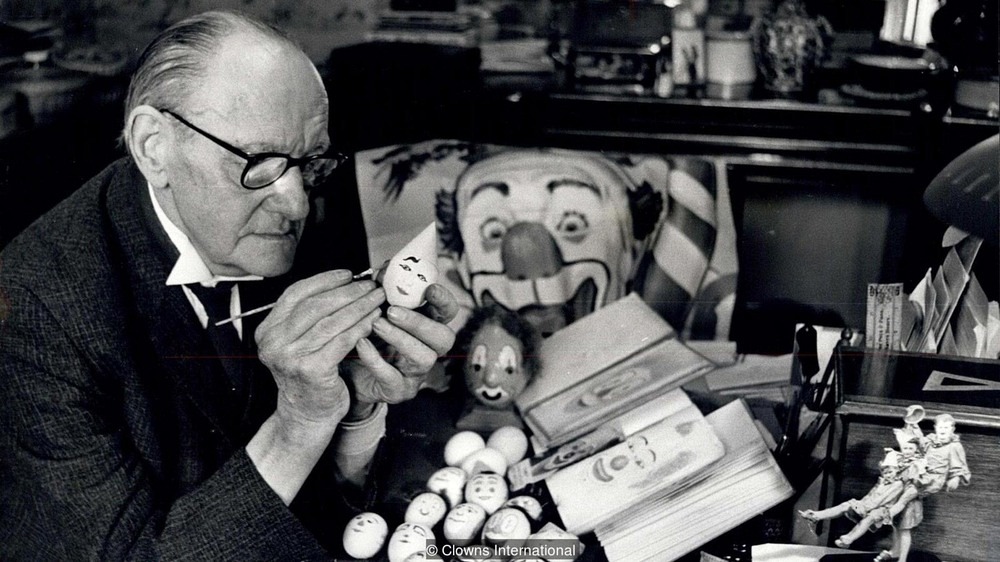Every clown’s face makeup is unique, or at least, they should be, for there is an unwritten rule within the clowning community that no clo...
Every clown’s face makeup is unique, or at least, they should be, for there is an unwritten rule within the clowning community that no clown should copy another clown’s look.
In order to copyright the specific facial designs of a clown, Clowns International—the world’s oldest clown society—maintains a register of clown faces. But instead of keeping photographs or sketches of the clown’s makeup, details are painted on ceramic eggs and decorated with collars, bow ties, wigs and miniature hats made from the clown's actual costume material.

Clown faces painted on eggs at the Clowns Gallery-Museum, London. Photo credit: Rob Greig
The tradition began in 1946, when Stan Bult—a member of the then International Circus Clowns Club, now called Clowns International— began painting the faces of prominent circus clowns on emptied chicken eggs as a hobby. Bult kept his collection at home and occasionally loaned it out for shows. He created about 200 eggs during his lifetime. Unfortunately, most of them were destroyed in an accident when it was lent out for an exhibition in the 1960s.
Bult's practice of painting clown's faces on eggs was resurrected in the late 1980s, only this time it became a sort of informal registry where Clowns International kept record of clowns’ facial makeup so that members could avoid copying one another. Clowns applied for clown eggs, and after Clowns International had screened the applicant, a professional artist would paint the faces on ceramic eggs. Only those working clowns with developed visual identities are allowed to have their faces painted on eggs. New clowns, young children, and non-performers do not make the cut.
Clown eggs are kept at only a handful of locations around the world. In the UK, there are two collections—one located at Wookey Hole in Somerset, and the other located at the Holy Trinity Church in Dalston. Wookey Hole contains the bulk of the collection—some 200 in number—including 40 of the original eggs painted by Stan Bult. Both collections are open to public.

Stan Bult working on an egg. Photo credit: Clowns International
Inspired by the British clown egg registry, an American couple created the US collection in around 1979. It now contains over 700 hand-painted eggs, according to this undated article, covering clowns of all types from around the world. Unlike the UK collection, the US egg collection is currently in storage and not publicly visible.
Mattie Faint, the curator of the Clowns’ Gallery at the Holy Trinity Church and a member of Clowns International, sees the registry more as a way of memorializing performers and of conferring prestige upon those who take the art of clowning seriously, than as a legal tool for enforcing copyright. Rarely do clowns try to copy each other because each clown want to look different in order to distinguish themselves. And even if one did try to copy another’s makeup, the differences in facial structure would likely still render the two clowns reasonably distinct, says Faint. Outright copying can also get a clown ostracized from the clown community, shunned by fellow performers and venues and even denied future work.
The clown eggs themselves do not comprise the registry. The actual registry is a written record complete with real name, clown name, date of membership, and serial number. The eggs are simply “the public face of the registration process,” says Chris Stone, another member of Clowns International.
Gareth Ellis, one of Britain’s most renowned circus clowns, regards the egg registry as a guideline of what to do and not to do with makeup, helping avoid repetition of a clown’s makeup designs. The egg registry provides a visual historical record of significant clowns, as well as shows the new talent coming into the field.

Photo credit: Luke Stephenson

Photo credit: Luke Stephenson

Photo credit: Luke Stephenson

Photo credit: Luke Stephenson

Photo credit: Luke Stephenson

Photo credit: Luke Stephenson

Photo credit: Luke Stephenson
